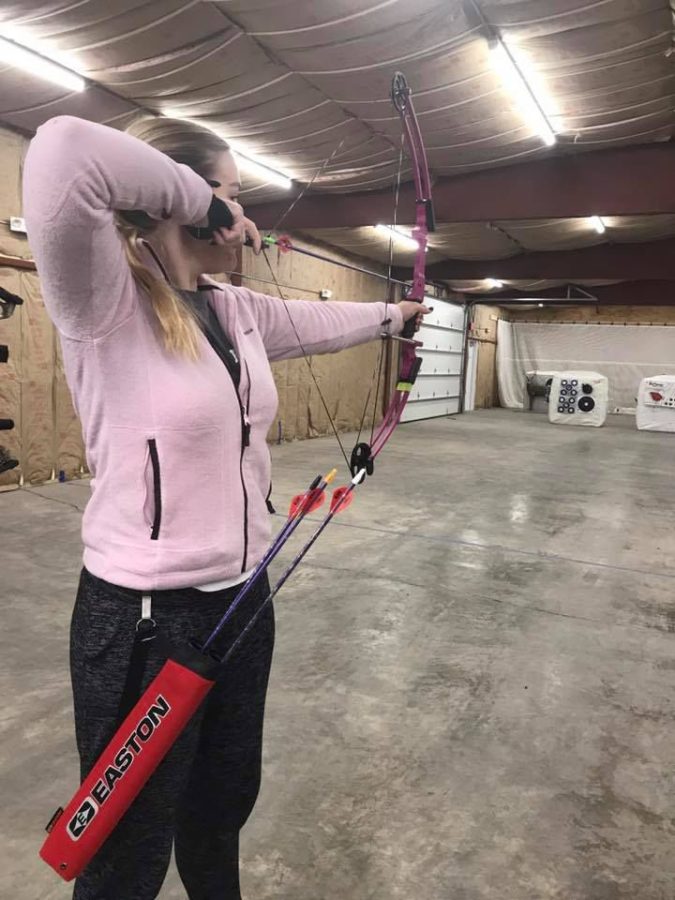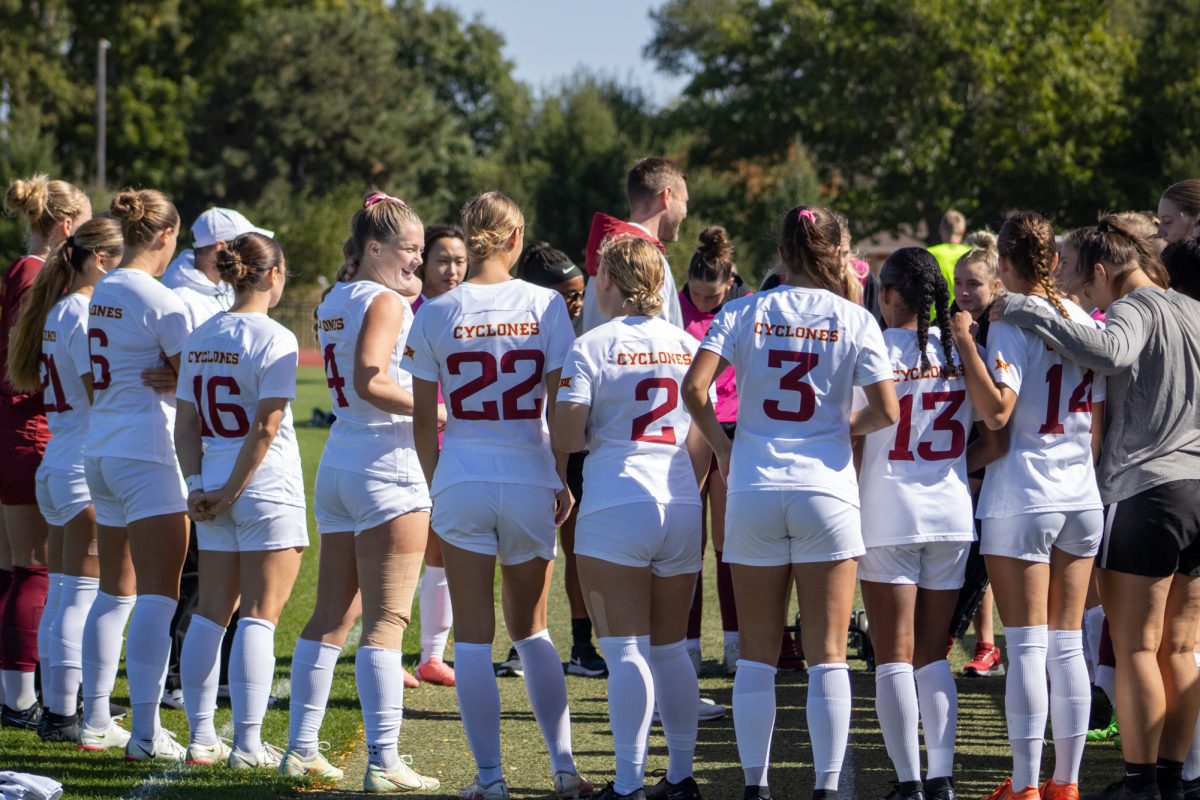Archery and Me: Reporter immerses herself into the Archery Club
November 14, 2017
“911” was painted in red on that Iowa State University sanctioned sign that greeted me as I walked into a warehouse off of State Avenue on Curtiss Farms. There were six young men with bows in hand, staring at me with a blank or confused expression.
“Hi, I’m Sarah,” I said.
No response.
“I’m here for archery?” Some of the tension swept out of the room as they began to ask me questions. The first one being, how much I knew about archery.
“I don’t know anything about archery,” I nervously heaved a laugh.
“Have you ever even shot a gun?” He responded.
“No,” I stated uncomfortably, and the puzzled looks returned.
“Now that’s just un-American,” another member stated and they all laughed.
I came in my fluffy, pink Columbia jacket, joggers and Nike tennis shoes, which stood out amongst the denim and camouflage. Letters and numbers were exchanged by members to discuss types of bows as if it were its own cryptic language that I hadn’t studied.
Understand this: I was an Iowa girl who grew up in a tourism-based town. I knew that agriculture was a big deal in Iowa and that hunting was as exciting as football for some people, but I, personally, had never been exposed to it.
Until the day I walked into the Archery Club.
“Why does mine look different than yours?” I asked a member.
There are different types of bows in archery, and the two I interacted with are recurves and compounds.
The club had very basic, what the members called “cheap,” compound bows for starters. While they may have thought the bow cheap, I found myself holding what would cost to buy one of my textbooks at $200.
When I asked them how much their personal compound bows cost, one member explained his entire kit would price out at about $600.
The compound bows were much different than the recurve bows in both cost and experience. The compound bow uses pulleys in the bow to help draw back the arrow. When I drew back the compound bow, I felt in control and powerful with the tension on the tip of my fingers. The target said otherwise when I didn’t make a puncture wound in its paper.
One member kindly let me borrow her recurve bow to test out. The recurve has a simple bend that turns away from the archer. There is no pulley system which means the tension of the bow will be pulled back by the archer’s own strength. While it definitely made me feel weaker when drawing back, I could have put on a hat and tights and been Robin Hood for all anybody else knew. Since there are less gears in the contraption, it’s much cheaper than a compound bow, averaging at about $100.
There are four types of bows. How do you choose the right one for you?
“Do as much research as you want [on a bow] and then test it out,” suggested Logan Armstrong, freshman in engineering and membership chair of Archery Club. “If you don’t like it after shooting it, try the next one. If you research [all of the types] all at once, you will get overwhelmed.”
Any selection has a poundage associated to them. I started with a compound bow at 15 to 20 pounds, which meant my arm was pulling back that amount of weight. Some bows can get up to 70 pounds. Armstrong broke it down to me in terms of another sport I’m awful at: bowling.
“The bow that you have is like using a four-pound bowling ball, where as [my bow at 70 pounds] is a 20 pound bowling ball,” Armstrong said. “It’s such a drastic change.”
“LIIIIINE OPEN!” One of the cabinet members will yell out this term when people are allowed to shoot. There must be something about drawing out the “i” that makes it official.
I was accessorized with two more objects to maximize my shooting experience. My quiver clipped onto my pants and hung at my hips in order to carry all my arrows.
The release was strapped around my wrist and was almost like a trigger. It clamped around the string and pulled back the arrow for me. When I was ready, I would wrap my pointer finger around the trigger, slightly press down and release my string and arrow.
Archers must be straddling the blue tape on the dusty cement in order to be able to shoot. They cannot cross the line until the line is closed due to safety concerns. Multiple times I watched people draw bows and arrows that remained stranded on the other side of the line, only six inches away from their feet.
When I heard the click of the arrow notching on the bow, there was some type of tingle I felt. The sound was so pleasing knowing that the arrow was locked in place and wouldn’t be going anywhere until I released the string.
The first time I drew back the string, it felt like I was cranking open my chest. I didn’t think much and let the arrow fly. It hit the netting hanging behind the targets, proving I was much too high.
“You need to aim just slightly lower,” Armstrong suggested.
Sure enough, I aimed lower and my arrow skidded across the cement floor.
“Only slightly lower,” he emphasized.
Since I was drawing my bow across my chest, my eyes were aiming fair above where my arrow tip was. Some members said I should bring my release up closer to my cheek, which would make my line of vision the line of the arrow.
I witnessed a few of them do it before attempting it myself. My fear stemmed from my nose being sliced off by the string. Sure enough, after I gave it a try I had a more accurate shot and my nose was still intact.
At points I questioned if I could be ready for Deer Classic, an archery competition in Des Moines, when I would make all arrows on the target. Then the next round I would hit everything, but the target.
After two weeks of practicing with the club, Armstrong gave me a B- for a grade.
“You did very well, very fast,” Armstrong said.
I have a lot to work on, including insight shooting. This is a mindset where you trust your instincts, picture where you would like the arrow to hit and adjust your bow accordingly.
Of course this would be my error, because I overanalyze everything and at the same time, I’m not patient. When I first shot, I was too high, then I was dramatically too low.
I took this information to heart and applied it while shooting the deer target. Now, I have shot at the deer target a total of three times.
The purpose of the deer is to give hunters practice aiming for the heart, lungs or liver which is the most humane way to kill a deer. On my first day, I shot the deer in the leg and the words of one of the members echoed in my head.
“If you don’t [hit its heart, lungs or liver] you feel bad because it’s running around with an arrow in its side.”
The second time I shot the deer, I pierced it’s ear. Not even joking, I think I did a better job than the store Claire’s does.
Finally, as I straddle the blue line 20 yards away from the deer, I envisioned my carbon arrows burrowing their way into the deer’s heart, lungs or liver, I tried not to let myself overthink the process. As I released the arrow, it flexed through the air and pierced the left lung of the deer. I victoriously raised my bow into the air and quickly called Armstrong to see my accomplishment.
In order to prove it wasn’t beginner’s luck, I was able to hit the lung again, only four shots later.
“Her name is Maizey,” I heard someone say as I walked into practice one night. Sure enough I was met with a corn colored snake in Armstrong’s hands as he lounged on one of the couches. They explained it was one of the member’s pets that was visiting for a practice.
This was by far the best conversation starter I’ve had while going to practices. According to the Iowa State website, there are 140 members of the Archery Club, but cabinet members estimate about 60 members are active.
As I made the cold walk from my car to the warehouse each night, I knew I would meet a new group of people, get more tips about archery and talk about a variety of subjects with complete strangers.
Kate Hakanson, senior in material engineering and vice president of Archery Club, was dating a member of the club a year ago who suggested she should go to a practice. She has only been a member for a year and still hasn’t purchased her own equipment.
“This is my built-in relaxation time during the week,” Hakanson said. “You shoot if you want to shoot. You don’t if you don’t feel like it that day.”
She compares drawing back a bow like riding a bike; after being away from it for a long time she knows how it feels: comfortable.
“I know exactly what the motion is and I’ll never forget that,” Hakanson said. “The learning curve is pretty easy to grasp, at least at the beginning.”
The atmosphere is laid back and Hakanson makes it clear that there’s no cut throat competition among the members.
“It’s a really low pressure club, which is really unique amongst other sports clubs especially,” Hakanson said. “But here… it’s all in good fun. There’s no requirements or expectations which is just such a nice break from school which is drive hard, work hard and do your best.”
Hakanson enjoys the individual goals that archery provides. Her goal is to continue to invest in the friendships she has made in the club with “some really awesome people.”
I feel the word “some,” was an understatement. These people took me under their wing, didn’t judge how many times I missed the target, trusted me with their expensive bows and taught me with such patience. They were all amazing people.
“You can fit in really easily here,” Armstrong said. “We’re all a mix-matched group of people who like to hang out and shoot archery.”
“So, are you going to come back after your article is done?” Luke McPherren asked me.
I looked around at the people in the room, glanced at the targets I had aimed at and considered all the feelings a bow and arrow made me experience and it was obvious.
“I don’t think there’s a way I could not come back,” I said to him.
That night I walked out of practice at 7:30 p.m. The days were short, which meant it was completely dark out. A car’s headlights crept over the Curtis Farms as it passed by on State Avenue. I turned around and realized there was one, measly light gleaming outside the warehouse. No one would ever know the kind of fun happening in that building, unless they took the time to walk in.
“If you can fall in love with [archery] and you want to fall in love with it, you will,” Armstrong said.







